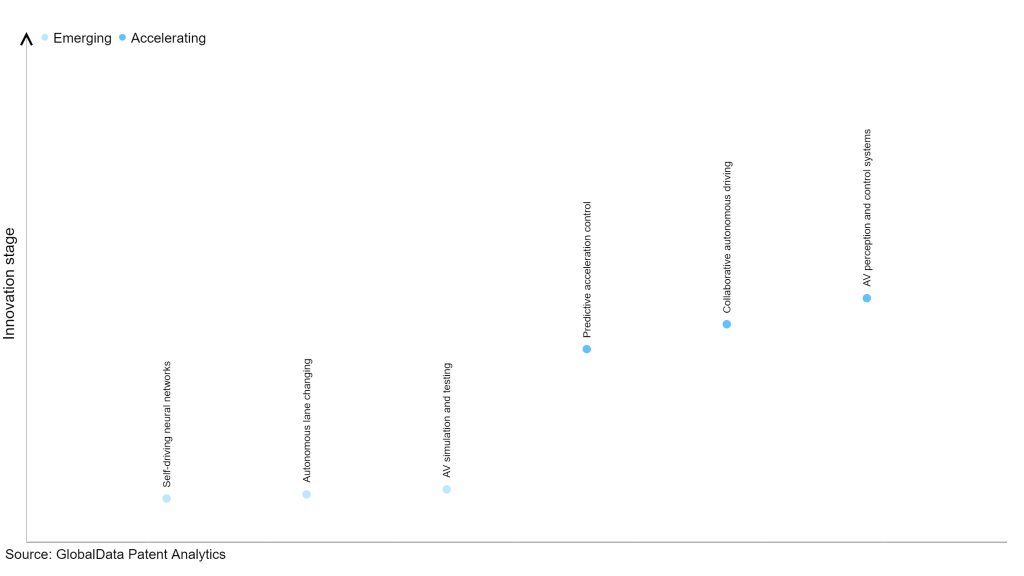The automotive industry continues to be a hotbed of patent innovation. The rapid pace of innovation in supervised neural nets is driven by the availability of large data sets, the development of new algorithms for training, the increasing availability of computing power, open source software, commercial applications, benchmarks, and new hardware architectures. The increasing availability of labeled data, data augmentation techniques, model compression techniques, and transfer learning techniques are also contributing to the development of more effective neural nets. These factors have enabled the training of neural nets on large data sets, achieving better results and enabling deployment on devices with limited resources. Self-supervised learning is a machine learning technique that trains models on unlabeled data, enhancing their performance in tasks like image classification and natural language processing. Large language models (LLMs) are neural networks trained on large text data, capable of generating text, translating languages, and answering questions. Transformers are a neural network architecture effective for natural language processing tasks, and generative adversarial networks (GANs) generate realistic data by training two models against each other. In the last three years alone, there have been over 720,000 patents filed and granted in the automotive industry, according to GlobalData’s report on Artificial intelligence in automotive: supervised neural nets. Buy the report here.
However, not all innovations are equal and nor do they follow a constant upward trend. Instead, their evolution takes the form of an S-shaped curve that reflects their typical lifecycle from early emergence to accelerating adoption, before finally stabilizing and reaching maturity.
Identifying where a particular innovation is on this journey, especially those that are in the emerging and accelerating stages, is essential for understanding their current level of adoption and the likely future trajectory and impact they will have.
300+ innovations will shape the automotive industry
According to GlobalData’s Technology Foresights, which plots the S-curve for the automotive industry using innovation intensity models built on over one million patents, there are 300+ innovation areas that will shape the future of the industry.
Within the emerging innovation stage, self-driving neural networks, autonomous lane changing and AV simulation and testing are disruptive technologies that are in the early stages of application and should be tracked closely. Predictive acceleration control, collaborative autonomous driving, and AV perception and control systems are some of the accelerating innovation areas, where adoption has been steadily increasing.
Innovation S-curve for artificial intelligence in the automotive industry

Supervised neural nets is a key innovation area in artificial intelligence
Supervised neural nets involve training a neural network on a labeled dataset, where the algorithm learns to predict an output based on input data. The training is guided by a supervisor who provides the correct output for each input, allowing the algorithm to learn and improve its predictions.
GlobalData’s analysis also uncovers the companies at the forefront of each innovation area and assesses the potential reach and impact of their patenting activity across different applications and geographies. According to GlobalData, there are 465+ companies, spanning technology vendors, established automotive companies, and up-and-coming start-ups engaged in the development and application of supervised neural nets.
Key players in supervised neural nets – a disruptive innovation in the automotive industry
‘Application diversity’ measures the number of applications identified for each patent. It broadly splits companies into either ‘niche’ or ‘diversified’ innovators.
‘Geographic reach’ refers to the number of countries each patent is registered in. It reflects the breadth of geographic application intended, ranging from ‘global’ to ‘local’.
Patent volumes related to supervised neural nets
Source: GlobalData Patent Analytics
Stradvision is one of the leading patent filers in supervised neural networks. It covers various technologies such as training, image recognition, natural language processing, machine translation, fraud detection, and medical diagnosis. Stradvision's patents protect its intellectual property and advance the state of the art. Some other key patent filers in the space include Meta Platforms and Enlitic.
In terms of application diversity, Meta Platforms leads the pack, while Enlitic and Tencent stood in the second and third positions, respectively. By means of geographic reach, Enlitic held the top position, followed by Tractable and Trax Technology Solutions.
To further understand the key themes and technologies disrupting the automotive industry, access GlobalData’s latest thematic research report on Artificial Intelligence (AI) in Automotive.
Data Insights
From

The gold standard of business intelligence.
Blending expert knowledge with cutting-edge technology, GlobalData’s unrivalled proprietary data will enable you to decode what’s happening in your market. You can make better informed decisions and gain a future-proof advantage over your competitors.



